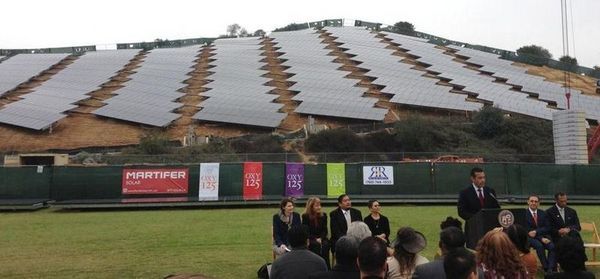L.A. Mayor Signs Solar Agreement With Tribe

Villaraigosa signs off on solar agreement at Occidental College, with solar panels in background | Photo: Refugio Mata, Sierra Club
It's official: the Los Angeles Department of Water and Power will be buying all the electricity generated by the first-ever utility-scale photovoltaic power plant built on tribal land. Los Angeles mayor Antonio Villaraigosa signed off on the agreement between the utility and K Road Power, which is building the 250-megawatt Moapa Solar Energy Center on land owned by the Moapa Band of Paiutes northeast of Las Vegas, Nevada.
The agreement, which has been wending its way from DWP through approval by the Los Angeles City Council and to Villaraigosa's figurative desk over the past few weeks, also provides future opportunities for DWP to buy out K Road and acquire the project outright. The project is expected to be delivering power to Los Angeles by 2016. Widely supported by the Moapa Band, the solar facility will occupy about 1,000 acres of tribal land in the shadow of the coal-fired, 557-megawatt Reid-Gardner Power Station.
The power purchase agreement between DWP and K Road extends for 25 years.
The Sierra Club's Beyond Coal campaign, which has been working to encourage DWP to give up coal-fired power, lauded Villaraigosa's approval of the agreement. The Sierra Club's Mary Anne Hitt, in a column at the Huffington Post, called the agreement "groundbreaking," saying:
This ground-breaking agreement is great news for everyone involved. From the Moapa Band of Paiutes, who are building the solar farm on their land; to the residents of Los Angeles, who will reap the benefits of cleaner electricity; to all Americans demanding a transition to clean energy; we salute the effective grassroots organizing by local citizens and strong leadership from city officials that brought this project to fruition.
DWP gets about 40 percent of its electrical power from coal-fired plants. That's a little more than ten times what the utility will derive from the Moapa facility at peak output. An important step, to be sure, but the utility still has a ways to go to fulfill its Sierra Club colleagues' directive of getting Beyond Coal. The Los Angeles City Council has approved funding to help DWP reduce its need for power from the coal-fired Navajo Generating Station in Arizona through energy efficiency measures, as well as additional renewable power purchase agreements like today's.
ReWire is dedicated to covering renewable energy in California. Keep in touch by liking us on Facebook, and help shape our editorial direction by taking this quick survey here.


